Flat feet
Let’s talk about flatfeet today.
Flat feet in and of itself is NOT a diagnosis and NOT the sole cause of your pain! You must be wondering why the others are not suffering pain like you from the flatfeet. Pain is multi-factorial and while having “flat feet” or dynamic overpronation can place the most stress on certain structures, our bodies are extremely strong and capable of handling that stress most of the time.
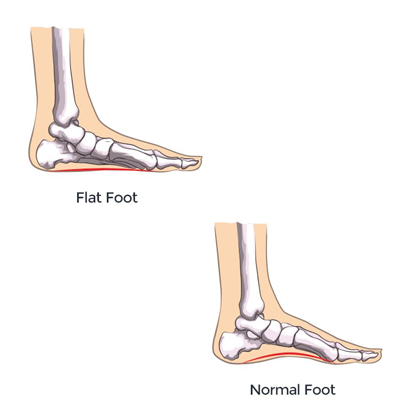
So, what is flatfeet?
If you look form the inside of an adult foot, you will usually see an upward curved and this is called foot arch. Several tendon and muscles work together to form the arch in your foot
The main 2 types of flatfeet are:
- Flexible flatfeet
There is an arch with no pressure on the foot, upon standing there is a loss of height of the arch due to foot ligament laxity (loose ligament), which allows the arch to fall. The arch can be restored by dorsiflexion of the big toe or tip toe.
- Rigid flatfeet
Rigid flat feet is a condition in which there is no arch to your foot, even when you are sitting. When a rigid flatfoot develops in adults, it is called “adult acquired flatfoot” or “posterior tibial tendon
dysfunction.” This type of flatfoot develops because of the weakening of the tibialis posterior muscle tendon, which is a major supporting structure of the foot arch.
What is the treatment option for flatfeet?
Treatment for flat feet and fallen arches depends on the severity and cause of the problem. If flat feet cause no pain or other difficulties, then treatment is probably not needed. There are quite a few varieties of treatment options for flatfeet including resting, stretching and applying ice. Custom orthotic insoles are often recommended by your health profession.
Can I prevent myself from getting flatfeet?
YES. You can avoid yourself from getting flatfeet or prevent your flatfeet from getting worse.
Physiotherapy often helps to assess individual issues, to identify the cause of your pain. Also, explain how the feet are the foundation of the entire body and keeping them strong will help alleviate pain throughout the body including ankle, knee and back pain. Your physiotherapist will customize an exercise program, whether to strengthen or improve the flexibility of the muscle according to the assessment.
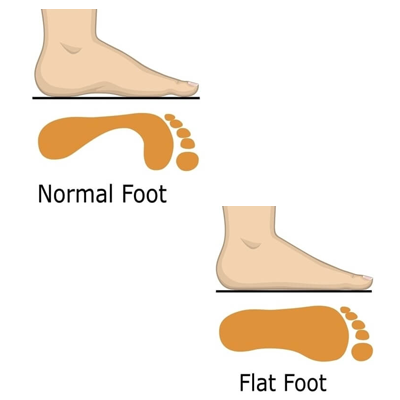
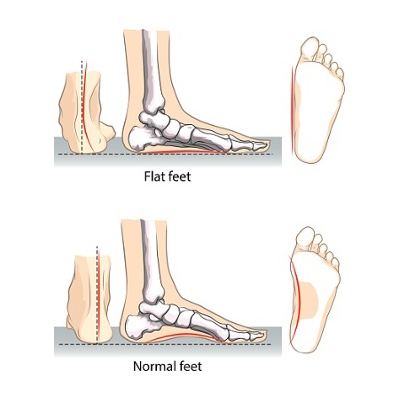
If the pain persists for more than one week, the best advice is to contact a physiotherapist for flat feet treatment to prevent unnecessary body pain.
Need any advice or consultation?
Please contact us at Rapid Physio Care, we are always here for you!
Looking to fix flat feet? We got you! But before we get into the exercises that can help address this “problem”, please make sure you have read our previous post.
In the previous post, I have mentioned our foot arches are supported by a group of muscles and tendons. Think about this, your flatfeet did not just develop overnight. Our bodies get into trouble when the loads we place on them are more than what they can handle.
When it comes to fixing flatfeet, strengthening and improving ankle mobility to potentially alleviate excessive stresses on certain foot structures. So here are some of the exercises that you can give it a shot!
Pain is the most common symptom associated with WMSDs. In some cases there may be joint stiffness, muscle tightness, redness and swelling of the affected area. Some workers may also experience sensations of “pins and needles,” numbness, skin colour changes, and decreased sweating of the hands.
Ankle mobility
Two simple exercises to improve your ankle range of motion and flexibility. This is one of the easiest ways to work on your ankle mobility
Ankle dorsiflexion mobilization
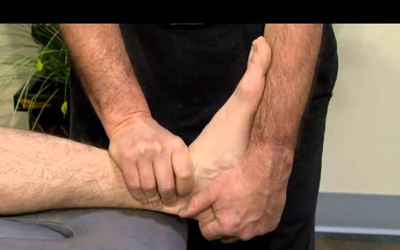
- On the floor, put your weight onto the knee and push forward
- Make sure your heel always in contact with the floor
- Bounce back and forth for 10 reps , push as much as possible and hold for 10 sec
Calf stretches (Gastroc and soleus)
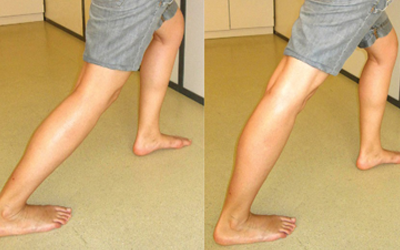
- On the wall, stretch one of your leg out and heel on the floor, lean against the wall. You should feel the stretch on your calf
- Sit back bend your knee and straighten the one that close to the wall
- Hold it for at least 30 secs , do it 5 times
Ankle and foot strengthening
All the mobility work in the world wouldn’t do anything if the muscles themselves that take the loads when the arch collapses or pronates are not strong enough!
Toes curls with towel
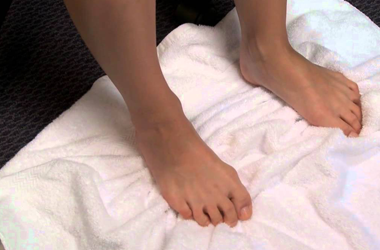
- Place a towel on the floor, curl as hard as you can, pick up the towel with your toes
- Hold for 10 secs , do it for 10 times
Strengthening foot arch
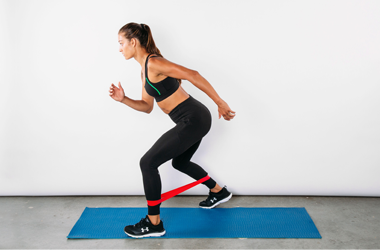
- Use an elastic band, place it around your foot.
- Curl your toes, resist the elastic band, to form an arch
- Hold for 10 sces , do it for 10 times
Hip, knee, ankle and foot strengthening exercise
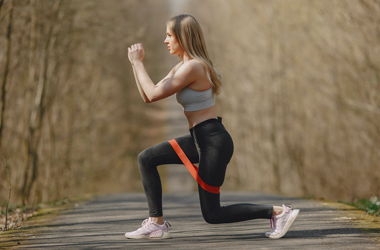
- Slightly bend your standing knee for more balance , use your toes to grab onto the floor
- Bend opposite knee and hip open to the side
- Do it for 10 reps x 3 sets
Side stepping lunges
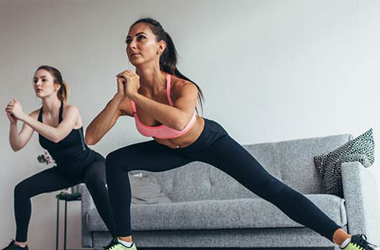
- Take a big step to the side , straighten your knee, you should feel the stretch at your inner thigh
- Step back and repeat for another side
- Left and right for 1 reps, do it 10 reps x 3 sets
Frequently Asked Questions
Are flat feet healthy?
Flat feet are not always unhealthy. Many people have flat arches and live pain-free without any limitations. The concern arises when flat feet cause pain in your feet, ankles, knees, or lower back often due to poor alignment or muscle weakness. If you notice soreness after long walks, uneven shoe wear, or difficulty standing for long hours, it’s best to consult a physiotherapist. A proper assessment can identify if your flat feet need treatment or just supportive footwear.
What causes flat feet?
Flat feet can develop for several reasons. Some people are born with naturally low arches (genetic), while others develop them over time due to:
- Weak foot or ankle muscles
- Overuse or long hours of standing
- Obesity or pregnancy (extra load on arches)
- Injury or trauma to the foot
- Conditions like arthritis or diabetes
Understanding the root cause helps your physiotherapist design a treatment plan including strengthening, stretching, and footwear advice to restore healthy foot mechanics.
How serious are flat feet?
Flat feet aren’t dangerous by themselves, but if left untreated, they can lead to problems such as chronic foot pain, heel pain, shin splints, or knee and hip misalignment. The seriousness depends on your symptoms. For mild cases, exercises and arch support are often enough. For more advanced cases, physiotherapy or orthotic inserts may be required to realign your feet and reduce pain during daily activities.
Are flat feet genetic?
Yes, flat feet can be hereditary. If one or both parents have low arches, there’s a higher chance their children will too. However, lifestyle factors can also contribute such as wearing unsupportive footwear, standing for long hours, or muscle weakness over time. Even if flat feet run in your family, regular strengthening and stretching exercises can help maintain good foot alignment and prevent pain later in life.
What are the stages of flat feet?
Flat feet generally progress through these stages:
- Stage 1: Arches appear normal but collapse under load (flexible flat feet).
- Stage 2: Arches flatten even at rest, causing mild pain or fatigue.
- Stage 3: The foot becomes stiff, and the heel starts to tilt outward.
- Stage 4: The misalignment affects the ankle, leading to chronic pain and instability.
Early diagnosis and intervention through physiotherapy can often stop progression and avoid surgical options later.
What is the best exercise for flat feet?
The most effective exercises strengthen the small muscles that support your arches. Common ones include:
- Toe curls: Pick up a towel with your toes to activate arch muscles.
- Heel raises: Stand on your toes and hold for a few seconds to build calf and arch strength.
- Arch lifts: While seated, lift only the arch without raising your toes or heel.
- Calf stretches: Help improve flexibility and foot alignment.
Doing these daily can improve stability and reduce discomfort. For best results, a physiotherapist can create a customized exercise plan after gait analysis.
Is walking barefoot good for flat feet?
It depends. Walking barefoot can strengthen your foot muscles if you have flexible flat feet and no pain. However, for people with rigid flat feet, weak arches, or alignment issues, going barefoot (especially on hard surfaces) can worsen symptoms. The best approach is gradual start barefoot on soft surfaces like grass or sand and use supportive shoes for longer walks. A physiotherapist can guide you on the right balance between support and strengthening.

